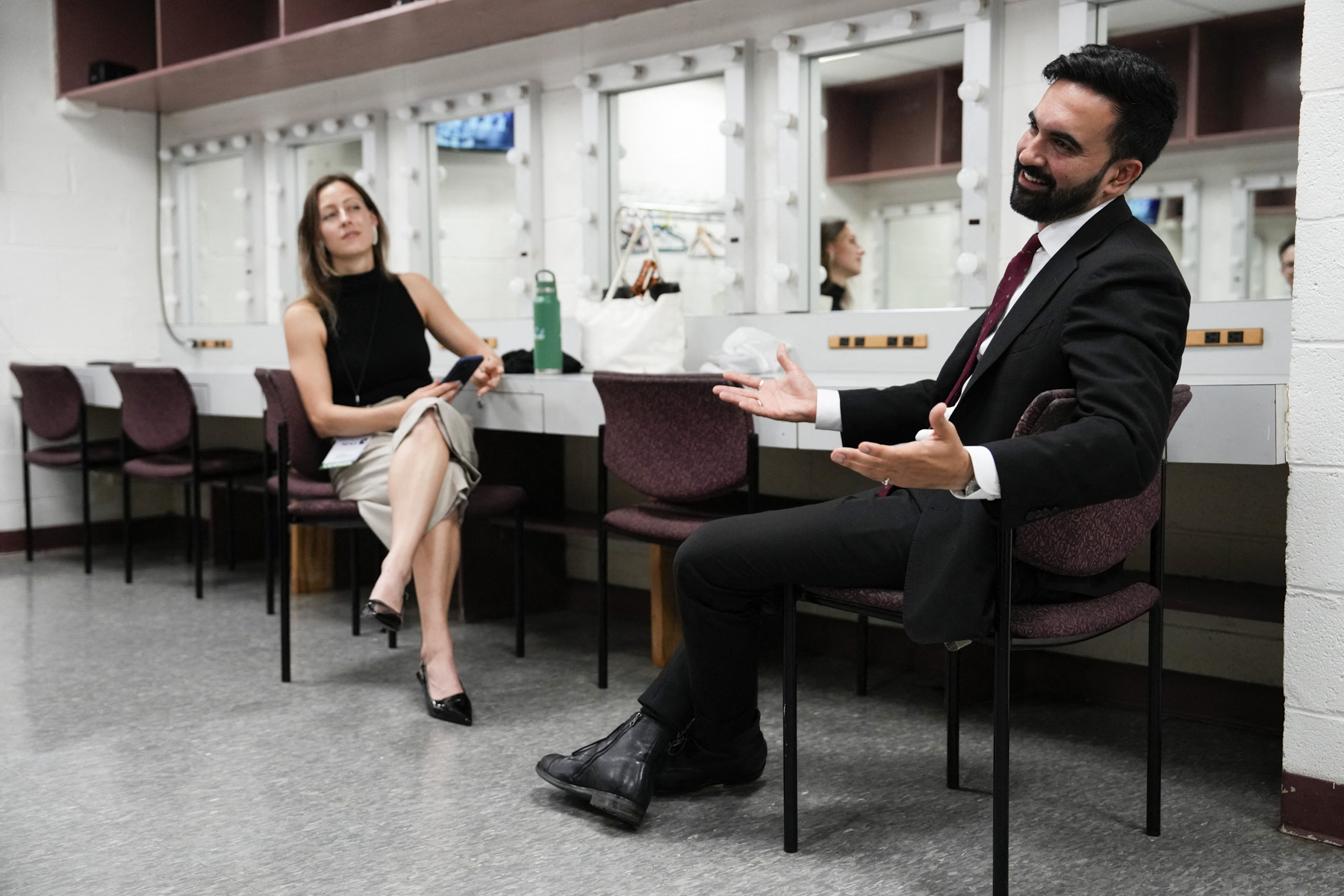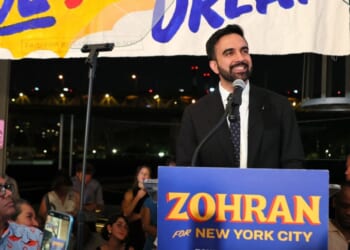In the aftermath of New York City’s recent Democratic mayoral primary, public attention on Zohran Mamdani has focused largely on his inflammatory rhetoric toward Israel and his embrace of radical socialist economics. While both warrant scrutiny, they have overshadowed a more immediate threat: Mamdani’s education agenda.
His proposals would not constitute mere reform; they would dismantle one of the few remaining pathways through which working-class families can escape chronically underperforming public schools: school choice.
Mamdani has endorsed deep cuts to charter school funding, opposed voucher programs, and worked to block co-location agreements that allow charter schools to share underused public school facilities. These measures would significantly hinder families’ access to schools with proven records of academic success. (RELATED: NYC’s Socialist Darling Said He Was Both ‘Asian’ And ‘African American’ On Ivy League Application)

Assemblyman Zohran Mamdani prepares before the New York City Democratic Mayoral Primary Debate at the John Jay College of Criminal Justice in the Gerald W. Lynch Theater on June 12, 2025 in New York City. Seven candidates will be participating in the final debate before the Democratic primary election for mayor. (Photo by Vincent ALBAN / POOL / AFP) (Photo by VINCENT ALBAN/POOL/AFP via Getty Images)
While Mamdani’s campaign outlines few specific education policies, the legislative record reflects consistent opposition to school choice and a preference for ideological conformity over demonstrated academic results.
Take Success Academy, the largest charter network in New York City. In 2024, 80% of its students with special needs passed the state math examination — nearly 3 times the citywide average for that group. English Language Learners within the network also achieve proficiency at significantly higher rates than their peers in traditional public schools.
Harlem’s District 5 offers a clear case study in the transformative potential of expanded school choice. In 2006, just 6% of students were enrolled in charter schools; by 2023, that number had risen to 62%. During the same period, overall student proficiency increased from 36% to 51% — a gain attributable entirely to the performance of charter schools. Traditional district schools, by contrast, demonstrated little measurable progress.
Beyond test scores, for many families, school choice offers access to specialized services often lacking in district schools. “School choice gives students the opportunity to attend full-time special education schools tailored to their needs — whether it’s Orton-Gillingham for dyslexia or multi-sensory approaches for ADHD,” said Dr. Emily Levy, founder of EBL Coaching, a specialized tutoring and educational services provider. “Being in the right special education environment all day, every day, can be life-changing for these students.”
Yet Mamdani has supported billions in symbolic expenditures that do little to improve academic outcomes. As a co-author of the “People’s Budget,” advanced by the Black, Puerto Rican, Hispanic and Asian Legislative Caucus, he has prioritized political messaging over educational effectiveness. The budget allocated $8 million for diversity-focused teacher recruitment, despite Black educators already comprising 42% of the city’s teaching workforce — nearly double their proportion of the population.
Additional funds included $250,000 for promoting “racial and cultural inclusivity” and $351,500 for conferences on supporting underrepresented educators. These initiatives, however well-intentioned, divert resources from the core mission of educating students in underserved neighborhoods. (RELATED: NYC’s Socialist Mayoral Candidate Proposes Blatantly Racist Scheme)
Mamdani argues that charter schools and voucher programs siphon resources, lack oversight, and primarily serve wealthier families. The data refutes this. Success Academy’s student body is 98% minority and overwhelmingly low-income, yet 96% passed the state math exam, and 83% passed English Language Arts — far above the public school average of 49%.
Dr. Levy highlights the systemic barriers that families in public schools face when seeking even the most basic accommodations. “Evaluations in public schools are often incomplete or minimal, giving an inaccurate picture of a student’s needs,” she said. “Many 504 plans are vague — for example, specifying ‘extra time’ without saying how much. Schools frequently lack the resources to fully implement accommodations, like proctoring tests in separate rooms.”
Her observations underscore a broader point: The problem isn’t just funding — it’s a system where bureaucracy and neglect leave many students without the support they need. “There’s definitely an economic divide,” Levy added. “Better-funded schools tend to have parents who know the system and advocate effectively, while under-resourced schools often have families unaware of what to ask or expect. Educating parents about their rights and the process would make a huge difference.”
Mamdani’s budget priorities also include $80 million in climate infrastructure upgrades for schools — changes that, while environmentally beneficial, have minimal relevance to student outcomes. At the same time, nearly 18% of classrooms in NYC still lack functioning air conditioning.
Mamdani’s education plan does not repair broken systems — instead, it creates new obstacles. Eliminating vouchers and restricting charter growth would undermine the families who rely on these schools for opportunity and stability. New York should expand successful charter models, not curtail them.
Other states provide evidence that school choice strengthens both charter and district schools. In Florida and North Carolina, the introduction of choice spurred gains across the board. Competition drives accountability. When charter schools succeed, nearby public schools improve as well.
Mamdani’s education agenda is a punitive, ideologically driven rejection of a model that delivers results. The students who benefit from charter schools are not affluent or privileged — they are children from immigrant households, low-income communities, and historically underserved neighborhoods. For many, school choice offers the only viable path out of generational poverty.
New York spends more per student than any other state — over $36,000 annually. The problem is not funding. It is systemic mismanagement, misguided priorities, and the elevation of politics over performance. Resources are consumed by bureaucracy and activism rather than directed to teachers, classrooms, and students.
If Mamdani’s vision prevails, it will not be the privileged who bear the cost. It will be New York’s working-class families — those who depend on education as their only ladder to a better life.
Gregory Lyakhov is one of the youngest nationally syndicated columnists in the U.S., driving conversations on education reform as an advocate for school choice and student-centered learning.




![Steak ’n Shake Mocks Cracker Barrel Over Identity-Erasing Rebrand [WATCH]](https://www.right2024.com/wp-content/uploads/2025/08/Steak-n-Shake-Mocks-Cracker-Barrel-Over-Identity-Erasing-Rebrand-WATCH-350x250.jpg)




![Mount Rushmore Could Get Trump Upgrade Under GOP Push [WATCH]](https://www.right2024.com/wp-content/uploads/2025/07/Mount-Rushmore-Could-Get-Trump-Upgrade-Under-GOP-Push-WATCH-350x250.jpg)
![Soros Network, Others Behind LA Riots [WATCH]](https://www.right2024.com/wp-content/uploads/2025/06/Soros-Network-Others-Behind-LA-Riots-WATCH-350x250.jpg)





